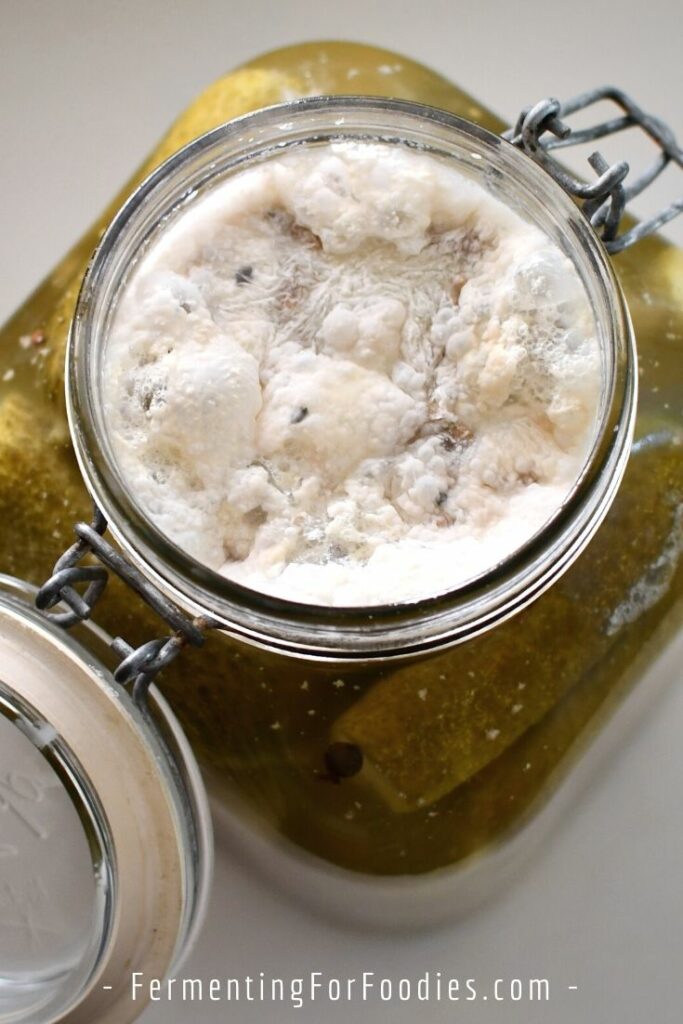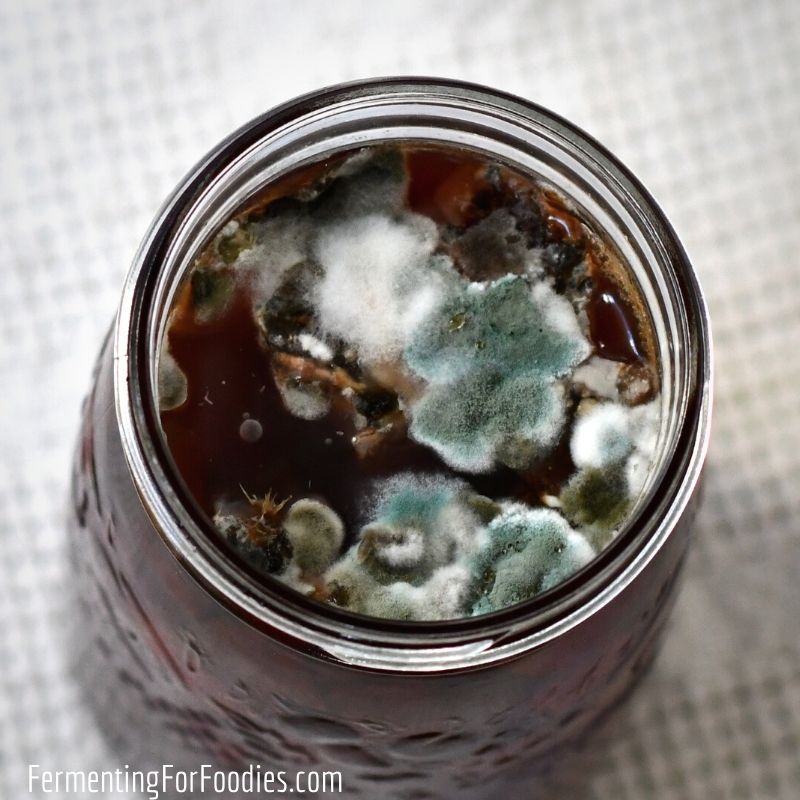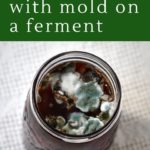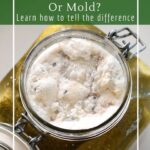It happens to all of us. You open a jar of sauerkraut or fermented pickles and there’s something unwanted growing on the top. Don’t worry! Here is everything you need to know about kahm yeast and mold.
- Is it still safe to eat?
- What is the difference between kahm yeast and mold?
- How can you prevent it from happening?
Check out this video where I discuss the difference between kahm yeast and mold.
Kahm Yeast
Kahm yeast is a wild yeast strain that forms a layer that completely covers the top of a ferment. If it’s been left to ferment for a while, it may have trapped air bubbles below the surface.
The picture below is kahm yeast growing over the top of fermented pickles. You can really see how it traps bubbles and forms a complete layer.

Is kahm yeast safe?
While kahm yeast is not ideal, it is not actually harmful. So it is fine to eat a ferment contaminated with kahm yeast.
I most often get it on my ginger beer, hot sauce, and apple cider vinegar.
Here’s how to deal with kahm yeast:
- If you find a layer floating on top of your ferment, you can skim it off. It will probably flake apart, but it’s perfectly safe to eat.
- However, the ferment will still be contaminated and the yeast will grow back again and again. So I recommend popping the ferment in the fridge so you don’t have to keep removing yeast.
- If the kahm yeast is on vinegar, then don’t worry about it. It will naturally die as the ferment acidifies.
Mold
Mold is a much bigger concern. It should be pretty obvious when a ferment has mold. It can be blue, green, black, brown, or white. It’s usually fuzzy looking, and unless it’s been there for a long time, it doesn’t cover the entire ferment.

When you see mold on top of a ferment it is just the sporing body. Like mushrooms and other fungi, most of the mold filaments (called hyphae) are unseen, below the surface.
There are certain kinds of mold that are perfectly safe to eat. These include blue cheese, miso, and tempeh. However, the majority of the molds are NOT safe to eat.
Here’s how to deal with mold on a ferment:
- If the mold is on sourdough starter, a fermented beverage, or a condiment, then throw it out. The hyphae will have contaminated the entire ferment. It can’t just be scraped off.
- The only type of fermentation that is safe to eat after mold contamination is salt-brined ferments. And there are still a few rules:
- The brine must be at least 2% salt to prevent the hyphae from growing in the liquid. So mold on a low-salt ferment isn’t safe.
- Remove the mold completely, it usually comes off easily enough. And remove any vegetables/fruits/etc. that were floating above the brine as they will be contaminated by mold.
- The salt-brine fermented food that remained completely below the brine is safe to eat. I recommend eating the ferment quickly, as the mold usually comes back within a few days of being removed.
- If eating a mold-contaminated ferment isn’t your thing, it’s fine to dump it into the compost. Never eat a moldy ferment that you are uncertain about. It’s always better to be safe.
Prevention
It is impossible to have a perfect ferment every time, but there is a number of things we can do to ensure that our ferments don’t get contaminated.
- Cleanliness: If you’ve had any mold or kahm yeast in your kitchen then make sure that you’ve sanitized all the affected jars and equipment. And be extra clean for the next few months.
- Temperature: Mold and yeast both thrive in warm temperatures, so try to ferment at less than 68 F (20 C).
- Air-tight ferments: If you don’t have a pickle pipe or fido jar then use a weight to make sure your vegetables are completely submerged below the brine.
- Follow the recipe: Use the right amount of salt in your brine. Keep other types of cultures well-fed and vigorous. That way the good bacteria/yeast/fungus in your ferment will help to prevent contamination.


Well i started to brew pineapple vinegar now what happen is
With in 7 days a thick jelly started forming i think so it might
Be mother of vinegar after that what i did is i filter the pulp and juice and kept this mother with this juice
Is this correct but i didn’t understand so fast the mother take place
Also let me know if i see this mother it that mean that my
Vinegar is ready or i had to wait
Hi, I haven’t made pineapple vinegar, so I don’t know if it has a mother, nor what the mother would look like. I know that pineapple makes stringy, clumping yeast when it’s used in other fermented beverages (kombucha or water kefir). Maybe that is what you are seeing? Good luck!
I have had success preventing or minimizing kahm yeast by adding a layer of olive oil on top of the fermentation….it’s a good fix and it’s edible!
Thanks for sharing! I haven’t tried that, but I can see how oil would create an effective oxygen barrier. Cheers!
I’ll try it
I used to cover my ferments with coconut oil that would harden and this also helped the veggies stay below but the one exception to topping with oil of any kind is if you have garlic in the ferment. Apparently, botulism can develop.
I’ve never tried that. Thanks for sharing!
What do you do to remove Kahm yeast in your ACV? Just learn to live with it?
Kahm yeast will naturally die as the ferment acidifies. So you don’t need to remove it or worry about it at all. Once it dies you can filter it out of your ACV (when bottling). The pickle photo was taken about 3 weeks ago. This past weekend the yeast was all dead… but I was impatient to eat the pickles so I didn’t take a photo. Cheers! Emillie
I am making flavored vinegar. I just looked at it and it has white spots on top that resemble snowflakes. Is this mold and can I just scrape it off?
Hi Cindy, Unless you added a lot of sugar to our flavored vinegar, it’s unlikely to have mold. However, if it’s mold it should be quite easy to scoop off. Kahm yeast will break apart and not be easy to remove. If it’s mold, then your vinegar may not be safe to use. (It will depend on the recipe). If it’s kahm yeast, then you can let it keep fermenting. Eventually, it will become too acidic for the kahm yeast to survive. Cheers!
Thank you Emillie!
It was my own flavored vinegar. It was infused with strawberries and regretfully I threw it out to be safe. I am wondering if you or anyone else has actual pictures of molds that grow on homemade vinegar as well as flavor-infused vinegar? I very much appreciate you replying to me!!!
P.S. Is it possible to ask you questions as I learn more about homemade vinegar-making for the novice? I Googled every vinegar site and it is so confusing. I actually found you and Glen and Friends, and I am happy I did!
Thanks for the information! How do I ‘finish up the ferment quickly’ for my ACV?
You don’t need to do anything different with kahm yeast on ACV. It will disappear as the vinegar acidifies. 🙂 My advice around finishing quickly is for fruits and vegetables, which get extra soft with kahm yeast. Enjoy!
Hello Emillie!
It’s been the first time I try to make apple vinegar. The alcoholic fermentation went great and then I put mother vinegar in the bucket I had the cider. I covered with a cloth and after a few days I had this white powder on top that looks to me is this Kahm yeast. I removed it with a spoon and now I am wondering, it will grow again, ok, I will remove it again, but does it prevent the mother to appear? What’s the best temperature for this fermentation and should I stir it often or not? How the mother will appear if this yeast keeps growing?
Hello, Kahm yeast is VERY common with ACV. (Happens in about 50% of my batches). You’ll know it was yeast if it was hard to remove. Mold usually has more structure, whereas yeast tends to flake apart. The good news is, that once your ACV acidifies the yeast will naturally die off. You don’t need to remove it. It will just settle down to join the spent yeast and bacteria on the bottom of your jar. Kahm yeast will probably reappear and stick around for about 1-2 months, then it will just disappear.
The only issue is that once you have kahm yeast in your ACV, it is in your indoor air. So you may find it on top of other ferments. Luckily it is perfectly safe and will always die-off eventually. Cheers, Emillie
And the mother will come after the yeast dies off?
Thank you so much for the quick reply and for your encouragement!!
The mother is probably already there. It’s just that the culture also contains kahm yeast as well as other forms of yeast, which is normal for ACV. Good luck!